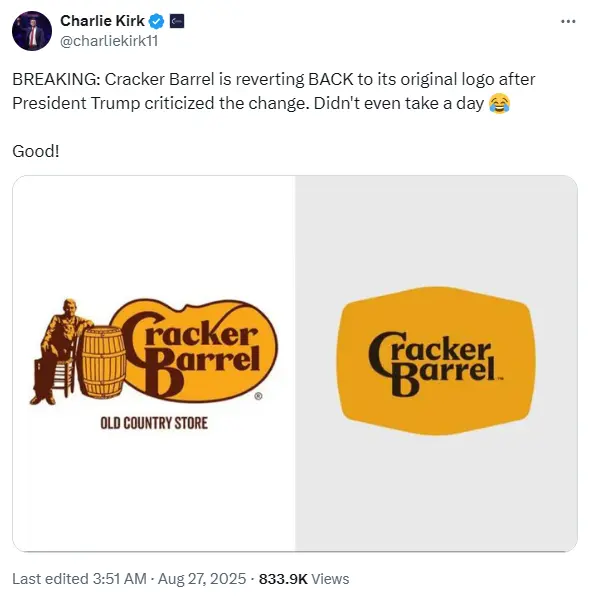The Rise and Fall of Cracker Barrel’s New Logo
WASHINGTON (TNND) — Cracker Barrel, the iconic Southern-style restaurant chain, has once again become the center of public debate following a controversial rebranding attempt that quickly backfired. The company recently confirmed it has severed ties with Prophet, the global consulting and branding firm responsible for the short-lived logo redesign and broader rebranding strategy. The decision comes in the wake of widespread criticism, falling stock prices, and growing pressure from loyal customers who felt the restaurant was straying too far from its roots.
This article takes a closer look at the unfolding situation — from the rebrand announcement to its backlash, Trump’s involvement, and the financial toll — while exploring the future direction of one of America’s most beloved dining chains.
The Rebrand That Sparked a Firestorm
In March, Cracker Barrel announced its ambitious three-year rebranding strategy, enlisting three outside firms to help rejuvenate the brand. Among them was Prophet, a high-profile marketing consultancy known for its modern, minimalist branding campaigns. Prophet spearheaded changes to Cracker Barrel’s longstanding imagery, including the decision to remove “Uncle Herschel” — the familiar illustration of an old man in overalls seated by a barrel — from the company’s logo.
The new look was intended to be cleaner and more contemporary, signaling a shift toward appealing to younger and more diverse audiences. Beyond the logo, Prophet also proposed a sleek redesign of Cracker Barrel’s interior spaces, including fewer pieces of the quirky wall décor that has long been part of the chain’s identity. The firm positioned this change as an effort to make the brand feel “less cluttered” and “more relevant” in a competitive casual-dining market.
However, what Prophet considered modernization quickly became a public relations nightmare.
Social Media Backlash and Trump’s Criticism
The rebranded logo and new aesthetic went live on August 19, but within hours, social media platforms exploded with criticism. Loyal customers argued that Cracker Barrel’s charm lies in its nostalgic, country-style atmosphere — a far cry from the modernized approach Prophet introduced.
Among the most high-profile critics was former President Donald Trump, who lambasted the redesign on his Truth Social platform, accusing the company of abandoning its “country values” in favor of what he described as a “woke corporate trend.” Trump’s remarks fueled an already heated debate online, amplifying discontent among his supporters and conservative communities who often make up a large portion of Cracker Barrel’s customer base.
Other influencers and prominent figures joined the chorus, calling the rebrand an unnecessary betrayal of tradition. Hashtags like #SaveCrackerBarrel and #KeepItCountry trended across X (formerly Twitter) and Instagram, highlighting how deeply customers associate the brand with nostalgia and Americana.

The Corporate Reversal
Just one week after the revamp was launched, Cracker Barrel abruptly reversed course. On August 26, the company issued a statement that both acknowledged the backlash and promised a return to the old branding:
“We thank our guests for sharing your voices and love for Cracker Barrel. We said we would listen, and we have. Our new logo is going away and our ‘Old Timer’ will remain.”
This decision was framed as a direct response to customer loyalty, but analysts suggest that the sharp decline in stock prices may have played an even greater role.
Financial Fallout: Stocks Take a Hit
In the days following the rebrand rollout, Cracker Barrel’s stock value plummeted more than 25%, a staggering blow for a publicly traded company. By the end of September, the stock closed at $44.19, reflecting an ongoing struggle to regain investor confidence.
The financial hit underscored how much damage a branding misstep can cause. Analysts have pointed out that restaurant chains, especially those with strong regional and cultural identities, must tread carefully when altering their public image. For Cracker Barrel, which has built its reputation on a “home-away-from-home” dining experience steeped in nostalgia, modernizing too aggressively appeared to alienate rather than attract customers.
Leadership Shake-Up
The fallout did not stop at Prophet’s removal. Alongside severing ties with the branding firm, Cracker Barrel announced that Cammie Spillyards-Schaefer, the Chief Restaurant and Retail Operations Officer, is no longer with the company. Insiders suggest that her departure was directly tied to the failed rebranding initiative, though official statements have framed it as a mutual decision.
The leadership shake-up signals that Cracker Barrel is taking accountability at the executive level, a move that may reassure shareholders and loyal diners alike.
Why the Rebrand Failed
Several factors contributed to the rebrand’s failure:
- Disconnect from Core Identity — Customers have always cherished Cracker Barrel’s old-fashioned, country-style aesthetic. The attempt to modernize was perceived as an abandonment of that identity.
- Cultural and Political Undercurrents — In today’s polarized environment, brand changes that even hint at “wokeness” often face outsized criticism. Trump’s involvement added fuel to the controversy.
- Timing and Execution — The rollout felt abrupt, with little explanation of why the changes were necessary. Customers saw it as sudden and unnecessary, rather than gradual and thoughtful.
- Economic Anxiety — With consumers already cautious about spending amid inflation and economic uncertainty, dramatic changes in branding may have created additional unease.
Can Cracker Barrel Bounce Back?
Despite the setback, Cracker Barrel still enjoys a loyal customer base. Industry analysts believe the chain can recover, provided it reaffirms its commitment to tradition while selectively modernizing in subtle ways. For example, updating menus, introducing technology for convenience (like mobile ordering), and improving operational efficiency could modernize the brand without alienating its nostalgic customer base.
Moreover, the company’s willingness to listen to its customers and admit mistakes quickly may ultimately strengthen its reputation. In an era where many corporations double down on unpopular decisions, Cracker Barrel’s reversal demonstrated a responsiveness that could resonate positively in the long run.
Looking Ahead
The Cracker Barrel saga is a cautionary tale for other heritage brands considering rebranding efforts. It highlights the delicate balance between staying relevant and respecting customer expectations. While innovation is essential in the competitive restaurant industry, identity and tradition remain equally vital to brand loyalty.
Moving forward, the company is expected to re-strategize its three-year branding plan, likely placing greater emphasis on incremental changes rather than sweeping overhauls. By focusing on improving the customer experience without compromising its iconic look and feel, Cracker Barrel has an opportunity to not just recover but thrive.
Conclusion
The failed Cracker Barrel rebrand underscores a crucial lesson: heritage and nostalgia cannot be easily replaced with modern minimalism. While Prophet’s vision for a sleek, contemporary Cracker Barrel may have made sense on paper, it clashed with the deep emotional connection customers have with the brand. The swift backlash, amplified by political commentary and economic anxieties, left the company with little choice but to revert to its roots.
As the chain works to rebuild investor confidence and reassure its customer base, it faces both challenges and opportunities. By re-embracing tradition while cautiously adopting modernization, Cracker Barrel can position itself for a stronger, more resilient future.

